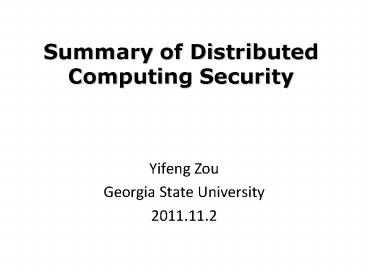Summary of Distributed Computing Security PowerPoint PPT Presentation
1 / 14
Title: Summary of Distributed Computing Security
1
Summary of Distributed Computing Security
- Yifeng Zou
- Georgia State University
- 2011.11.2
2
- Summary about distributed computer security
issues discussed in chapter 8. - Recent work in distributed computer security
area. - Potentially future work in distributed computer
security area.
3
Why security?
- A distributed computer system can be described
as a collection of clients and servers
communicating by exchange of messages. - System is running in an open environment
- Need to communicate with other heterogeneous
systems
4
Security issues
- Access authorization
- One must be authorized to access the
distributed computer system - Message security
- Passing message confidentially between
nodes using some cryptographic techniques - Mutual authentication
- Two way authentication, both parties
authenticate each others identity suitably
5
Categories of access authorization
- Discretionary access control
- Access control matrix (ACM)
- Implemented via access control list or
capability list or both. - pros and cons
- Mandatory access control
- Represented as information flow among
communicating entities. - Lattice model-information flow can be
controlled by labeling communication entities. - Bell-Lapadula model Biba model
6
Cryptographic techniques
- private and public key systems
- Both provide integrity and authenticity of
messages in addition to secrecy - symmetric encryption private key
- asymmetric encryption private key public
key - Implemented using intricate algorithm like
RSA, DES. - distributed authentication protocol
- Maintain three basic properties
authenticity, integrity, - and freshness.
- mutual authentication protocol
- characterized by whether a third-party
authentication server is assumed and by how the
freshness of messages is guaranteed.
7
Recent work
- Date Security management in distributed computer
systems. - From a system point of view it is
possible to point out the following threats from
distant stations in distributed computer system. - The work stations approval mechanism of the users
may be partial or non-existent. - It is possible to carry out automation of the
Login procedure. - The work station may be installed in a public
area or in a high risk area. - The work station may activate strong utilities or
development devices and thereby try to bypass the
security mechanisms. - In extreme cases the user may pretend to be
another user and infiltrate the system.
8
The distributed security approach
9
- software architecture
- The access security system software may
operate at each of the network stations as an
independent application. The various applications
will receive the access security services via an
access security interface which must be
incorporated in each application where these
services are required.
10
- 2. Distributed Network Security Management
Using Intelligent Agents - Introduced a novel architectures and mechanisms
based on Intelligent Agents Technology in order
to approach efficient, flexible, adaptable and
effective solutions. - focus on network intrusion detection systems and
present two specific systems DIDS (Distributed
Intrusion Detection System) and CSM
(Co-operating Security managers). - Basic distributed components like authentication,
authorization, encryption and access control
should be included in this intelligent agents.
11
A simple example diagram for IA
12
Future work
- Current encryption algorithm are sometimes
expensive to execute and can be decrypted with
some known information. A more efficient and
secure algorithm is needed to achieve the
security goal. - Techniques to identify the eavesdropper in the
communication network quickly and correctly. The
intelligent agent is a good practice whereas it
must introduced an third party monitor to the
distributed computing system. And that monitor
can be a potential secure issue in terms of
system attack. - As cloud computing has been widely used in recent
years, the security issue becomes a harder
problem since more computers in scattered
locations join the system. Challenging work is
proposed to ensure the safe communication among
these endpoints.
13
References
- R.Chow, T.Johnson. Distributed Operating system
Algorithm,1997. - Adi Armoni, Data Security Management in
Distributed Computer Systems, Informing Science,
Volume 5, 2002. - K. Boudaoud N. Agoulmine J.N De Souza,
Distributed Network Security Management Using
Intelligent Agents,2004. - Mirtaheri S.L, Khaneghah E.M, Sharifi M, Azgomi
M.A The influence of efficient message passing
mechanisms on high performance distributed
scientific computing, Parallel and distributed
Processing with Applications 663-668, 2008. - Naqvi, S. Riguidel, M., Security architecture
for heterogeneous distributed computing systems,
security technology, 38th international
conference, 2004. - Edara, U.R. Subramanian, N. Dwivedi, M. Sinha,
A., A system for security assessment grid
environment, 2010 IEEE 4th international
conference, pages16, 2010.
14
- Thanks

